
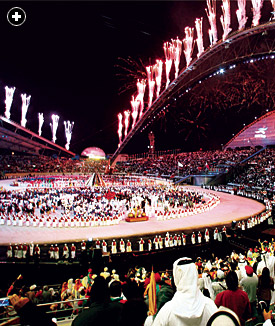 |
| The opening ceremony featured more than 8000 performers from 20 countries. |
| EPA / CORBIS |
The biggest gathering of athletes in history. The first major international multi-sport event to be hosted by an Arab country. The world’s largest video projection, against a backdrop of dazzling pyrotechnics. All describe the 15th Asian Games staged in Doha, Qatar last December. Like the little engine that could, tiny Qatar put on two weeks of sport with style that will be hard for even the Olympics to top.
 he Asian Games brought together 12,500 athletes —1500 more than the Olympics—all from the largest, most populated continent on the planet. They competed in 39 sports—11 more than the Olympics. A quadrennial tradition in Asia since 1951, the Asian Games have most often been staged by the athletic powerhouses: China, Japan, Korea and India. The only other Middle Eastern country to host them was Iran in 1974.
he Asian Games brought together 12,500 athletes —1500 more than the Olympics—all from the largest, most populated continent on the planet. They competed in 39 sports—11 more than the Olympics. A quadrennial tradition in Asia since 1951, the Asian Games have most often been staged by the athletic powerhouses: China, Japan, Korea and India. The only other Middle Eastern country to host them was Iran in 1974.
Sports are not new to Qatar. The oldest national federations, in soccer and table tennis, were established in the 1960’s, before independence from Britain in 1971. Since then, Qatar has transformed itself from a British protectorate noted mainly for pearling into one of the world’s most affluent countries.
 |
| Bahrain’s Ruqaya Al-Ghasara waves a Bahraini flag after winning a gold medal in the women’s 200-meter race. Below: Iran’s Hossein Reza Zadeh lifts 230 kilos (506 lbs) during the weightlifting competitions to win one of his country’s 48 gold medals. |
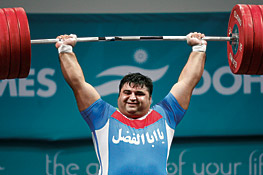 |
| TOP: AL BELLO / GETTY IMAGES; BOTTOM: EPA / CORBIS |
As part of its quest to diversify an economy based on oil and gas, the Connecticut-sized nation on the Arabian Gulf went after the Games in a big way. With a population the size of Denver’s, this entailed hiring expertise from Australia, Europe and North America to help plan the Games while thousands more, largely from South and Southeast Asia, helped build and renovate 44 sport venues, roads and housing for athletes.
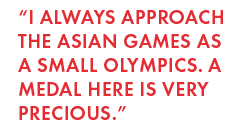
“Sport is the shortest way to be part of the world. It’s the language between nations. It builds human character and takes care of the human spirit,” says Muhammad al Malki, president of the Qatar Sports Press Committee. “We are looking to be part of the world and create friendship with others. There has been no civilization without sport.”
The $2.6-billion Asian Games are the biggest international athletic competition ever held in Qatar, but not the first. In its quest to carve a niche as a premier international sports capital, the country recently hosted the West Asian Games, the International Triathlon Union world cup, major championships in soccer, track and field, golf and tennis, and a congress on sports science. And Doha, the upstart capital that pledged —and built—a new $700-million “Sports City,” beat out heavyweights Hong Kong, Kuala Lumpur and New Delhi to host the 2006 Asian Games.
Like other international sporting events, the Games attracted high-caliber athletes, such as Olympic bronze medalist equestrian Khaled Al ‘Eid of Saudi Arabia, Olympic gold medal cyclist Zulfiya Zabirova of Kazakhstan, Indian tennis star Sania Mirza and world-record weightlifter Hossein Reza Zadeh of Iran.
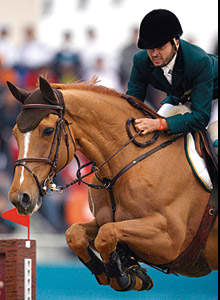 |
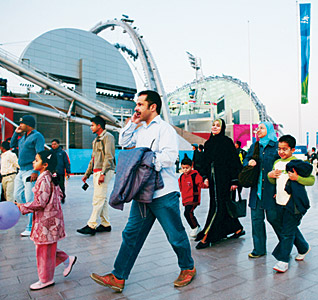 |
| Khalid Al ‘Eid of Saudi Arabia clears an obstacle on his horse Al-Riyadh to secure the gold for his equestrian team. Right: Spectators arrive at the newly renovated Khalifa Stadium in Doha. |
| MARWAN NAAMANI / AFP / GETTY IMAGES; RIGHT: PAUL BRONSTEIN / GETTY IMAGES FOR DAGOC |
“I always approach the Asian Games as a small Olympics. Asia is more than half the population of the world. It is always nice to compete with Olympic champions. A medal here is very precious,” said Khazak swimmer Vladislav Polyakov.
The Games highlight the so-called “rice curtain” that separates East Asia and West Asia: China led the medal count with 316, with Japan and Korea trailing distantly at 198 and 193, respectively. Kazakhstan reaped the fourth largest medal harvest at 85. West Asian countries were led by Iran, which finished sixth overall with 48 medals, and Qatar, which finished ninth with 32.
However, this numerical landscape is changing. China fell 18 gold medals short of its Games record of 183, captured in Beijing in 1990. Athletes from Arab countries increased their total medal count to 111, doubling their winnings from the 2002 Asian Games in Busan, Korea.
Of course it is usual for national teams to perform better when the Games are on their own turf and athletes are inspired by the passion of their own fans. But Qatar’s success on the field amazed everyone, leaving an inspiring legacy for the whole country and the wider Middle East. Qatar’s medals included some of the most prestigious of the Games, such as the men’s golds in soccer and equestrian and silver in basketball.
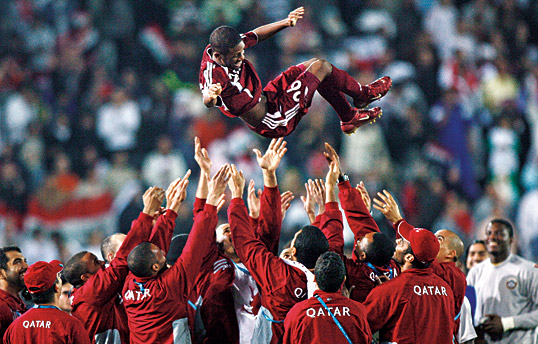 |
| After their 1–0 victory over Iraq in the men’s football (soccer) final, teammates give Qatar’s Khalfan Ibrahim Al-Khalfan a celebratory toss. |
 |
| Iraq supporters cheer on their team during the final game. Below: Showing his enthusiasm with an art car, a Qatari man gives the Asian Games a thumbs-up. |
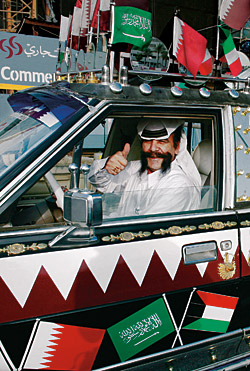 |
| TOP: KARIM JAAFAR / AFP / GETTY IMAGES; CENTER: RICHARD HEATHCOTE / GETTY IMAGES FOR DAGOC; BOTTOM: PAULA BRONSTEIN / GETTY IMAGES FOR DAGOC |

“The victory has a special taste,” says Uruguayan-born soccer forward Sebastián Quintana. “It’s very important for Qatar, and to win the last gold medal of the Asian Games was something really special for us.”
The East–West athletic divide reflects the difference both in resources and in the cultural importance given to athletics. East Asian teams view the Games as a tuneup for the next Olympics. With the absence of some of their top talent, such as basketball’s Yao Ming, it was also an opportunity for some of their second-tier athletes to compete internationally. Meanwhile, for many West Asian teams, it was a chance for some friendly intra-Arab competition.
“We are all very happy because we broke the Kuwait and Arabian Gulf records, and everybody on the team made new personal-best times,” swimmer Marzouq al Salem noted.
For West Asian countries, the Games are also an occasion to develop athletics among women and girls. Throughout the region, greater numbers of women and girls are participating in sports. “We start in the schools and use them as training centers. The parents of the girls are okay with it because sports are part of the schools,” explains Ahlam al Mana, head of the Qatari women’s teams.
The Games are also an effort to promote a pan-Asian identity and, like the Olympics, to use sport to transcend political, cultural and religious differences. Along Doha’s waterfront, a photo exhibit titled “Unity of Asia” called Asia “our common home.”
 |
| China’s forward Zhu Fangyu helps his team beat Qatar in the men’s basketball final. |
| CPSA / NEWSPORT / CORBIS |
While many sports at the Games, such as basketball, have their origins in the West, others originated in the East and have swept the continent. For example, since taekwondo, a Korean martial-arts sport, was introduced at the Games in 1986, 21 countries have won medals in it. Indeed, spreading both the medals and the host venues among Asian nations is one of the goals of the Games. Thirty-eight countries medaled at the Qatar Games, and the Olympic Council of Asia has regional competitions, such as the next West Asia Games, planned for 2009 in Yemen and has scheduled the 2010 Asia Beach Games in Oman.
“Allowing smaller countries to host different multi-sport events gives them the opportunity to share the principles of unity and solidarity in the continent, since those kinds of games do not need a huge budget like the Asian Games,” says Sheikh Ahmed Fahad al Sabah of Kuwait, president of the Olympic Committee of Asia.
Organizers introduce new sports into each edition of the Asian Games. In Qatar, triathlon, chess and a 120- kilometer (75-mi) endurance equestrian relay race all made inaugural appearances. The former was chosen because it is an Olympic sport, increasingly popular, and has television appeal for the Games. The latter two were selected because of their Middle Eastern roots.
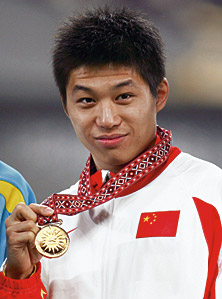 |
| Li Yanxi of China poses with his gold medal, won in the triple jump. China took 316 gold medals during the Asian Games. |
| MICHAEL STEELE / GETTY IMAGES FOR DAGOC |
The Asian Games have another similarity with the Olympics: controversy. In addition to the long-standing question of professionals competing against amateurs, the common American and European practice of hiring top-notch athletes and coaches from other countries has begun to spread to those Asian countries that can afford it. For example, Qatar’s basketball coach is American Joseph Stiebing, and most of its soccer players are trained in Europe or Latin America.
“It is legal to bring athletes from outside the country,” al Malki says to critics. “Much of the world does it. We are a small nation, and to get results we need stars.”
Also like the Olympics, the 15th Asian Games had their share of upsets. These usually came at the expense of China, which entered the competition with the prospect of medaling in every sport. However, Kuwait beat them at men’s handball and Uzbekistan beat them in men’s and women’s lightweight double-scull rowing.
While sports have become a key part of Qatar’s identity, the nation’s athletic door did not close when the torch left Doha on December 15 for Ghangzhou, China, where the next Games take place in 2010. Qatar is bidding to host the 2016 Summer Olympics, a quest that will take a combination of world-class facilities, organization, experience and a regional fan base to fulfill. With a vision of that future, Sports City, the main competition venue of the Asian Games, will become a youth sports training academy.
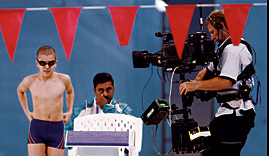 |
 |
| The youngest athlete at the Games was 10-year-old Amer Ali of Iraq, who swam the 200-meter individual medley. Right: Sri Lankans Athula Russell and Chinthaka Galappaththi face off during the men’s rapid chess individual competition, one of several sports first added to these Games. |
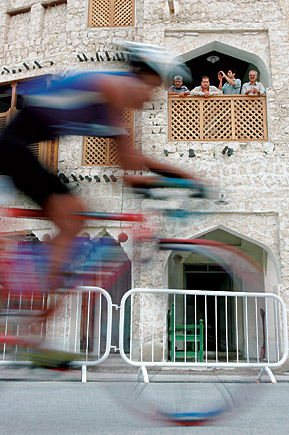 |
| Spectators in the Qatari town of Souqs view competitors during the cycling portion of the men’s triathlon. |
| TOP LEFT: JASON REED / REUTERS / CORBIS; TOP RIGHT: STREETER LECKA / GETTY IMAGES FOR DAGOC; BOTTOM: JEFF GROSS / GETTY IMAGES FOR DAGOC |

Meanwhile, just as Qatar put its imprint on the Games, the Games transformed Qatar. When the torch arrived in the gleaming skyscrapered capital of Doha after weaving through 15 countries and regions of Asia, the city’s Corniche came alive. Throngs of young men and women, many hanging out the windows of honking cars, waved Qatari flags and cheered the flame that ignited the city with the spirit of the Games.
“The city is buzzing and has become more beautiful,” says Vibha Nanda of India, who has lived in Doha for three years with her husband, a banker, and their two sons. She and her family have been watching a Syrian dance troupe perform on the Corniche, one of many free cultural performances associated with the Games.
The 15th Asian Games were not just about putting Doha on the map in a sporting sense, but they also let Qatar, acting as flag-bearer for the whole region, do something no Arab country had done on this scale. Now others may follow—perhaps all the way to the 2016 Olympics.
“It’s not every day you have the Asian Games on your door- step,” echoes Nanda’s husband, Sandeep, as an entertainer on stilts lurches by.
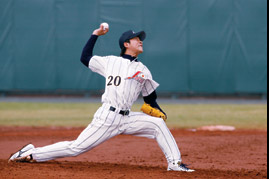 |
 |
| A motionless judge watches as Japan’s Yusuke Fukuda and South Korea’s Lee Cheon Woong flow through a fencing bout. Right: Japanese pitcher Satoshi Komatsu pitches to a batter from Korea. |
| CAREN FROUZ / REUTERS / CORBIS; RIGHT: BOBBY YIP / REUTERS / CORBIS |

 ow to hush a crowd of 50,000? Announce they are about to be seen by half the planet. “The tv broadcast is about to begin. Please be sure to be in your seats when Doha goes live to the world,” a female voice booms from the loudspeaker at Khalifa Stadium, showplace of the 15th Asian Games.
ow to hush a crowd of 50,000? Announce they are about to be seen by half the planet. “The tv broadcast is about to begin. Please be sure to be in your seats when Doha goes live to the world,” a female voice booms from the loudspeaker at Khalifa Stadium, showplace of the 15th Asian Games.
Indeed, the opening ceremony brings Qatar to much of Asia, if not the whole world, in a dazzling visual and auditory feast of choreography, music and technology. “These Games represent a great opportunity to unify people through sport, to obtain further cooperation and reconciliation, to understand and accept diversity and differences, and to work toward the fundamental principles of sport, which go far beyond the physical,” Shaykh Tamim bin Hamad al-Thani, heir apparent of Qatar and chairman of the Asian Games, tells the crowd.
As the performance, five years in the making, begins, something entirely unrehearsed happens: A torrent of rain blends with the gold- and ruby-colored confetti falling from the sky. Undeterred, the stadium lights up to create a magical fairy tale in which performers present Qatar’s desert and maritime cultures. A boy—“The Seeker”—in search of a magical armillary sphere, is carried by a mechanical golden falcon that deposits him on a mountaintop. Here begins his adventure along the Silk Roads, the ancient trade routes that crossed Asia from the Pacific to the Mediterranean, transmitting and transforming culture, commerce, science and religion for millennia.
The tale unfolds, with 8000 performers from 20 countries telling the story of the great regions of the Asian continent and the major eras of civilization, beginning with the era of Arab and Islamic science and mathematics and its advances from the eighth to the 15th century. From there, the journey continues to the Renaissance, Enlightenment, Industrial Revolution and, finally, the Digital Age, where strips of live flame representing oil and gas crisscrossed the stadium floor, warming fans in the uncharacteristically chilly night.
In addition to an estimated television audience of 1.7 billion, the 3½-hour opening ceremony’s sold-out crowd includes thousands of Qataris, heads of state from more than a half dozen Asian countries and presidents of such major athletic bodies as the International Olympic Committee and the Fédération Internationale de Football Association (FIFA), governing body of the World Cup.
“Having the Games in Doha is a surprise,” says hometown Doha fan Ahmed Saleh, who brought his 11-year-old twin son and daughter to the opening.
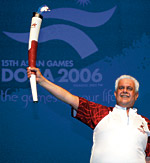 |
| The final torchbearer was Qatar’s Minister of Energy and Industry, Abdullah bin Hamad al-‘Atiya. |
| YONHAP / EPA / CORBIS |
The opening ceremony is produced by the same Australian team that created the opening ceremonies for the Sydney Olympics. But tonight’s show in the newly renovated Khalifa Stadium is setting new benchmarks for such productions in choreography, storytelling and technology. Engaging 100 artists, musicians and composers from Qatar’s cultural community, Games organizers seized the opportunity to promote Qatari and Asian culture and history.
Indeed, music from Japan, Singapore, Lebanon and Qatar is woven throughout the ceremonies, along with dancers and acrobats from Syria, the Philippines, Kazakhstan, China and Japan. With a nod to universal pop culture, Chinese pop star Jackie Chueng performs, as well as Spanish tenor José Carreras, Bollywood actress Sunidhi Chauhan and Lebanese singer Magida Al Roumi.
After the show, the parade of athletes by nation is as colorful as any Olympic procession. Iranian women dress in elegant aqua tunics, pants and headscarves. The Maldives’ male athletes cover their heads, but the women do not. China marches in, 713 strong; Korea and Japan have each brought more than 600 athletes. The last and largest of the West Asian delegations to enter the stadium is Qatar, with 360 athletes. They enter the stadium wearing the white and burgundy colors of the country’s flag.
The parade of nations sets up a friendly East Asia versus West Asia rivalry that will be one of the themes of the Games. Fans on one side of the stadium cheer wildly at the introduction of West Asian delegations into the stadium, such as Saudi Arabia, Lebanon and Iraq. Competing cheers from the other side of the stadium erupt when athletes from China and Japan and a unified Korean delegation make their way around the arena.
 |
 |
| Two rain showers failed to put out the spark of the opening. Right: To light the cauldron that burned throughout the Games, Qatari endurance equestrian team captain Shaykh Muhammad bin Hamad Al-Thani rode his horse to the top of Khalifa Stadium. |
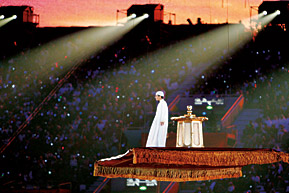 |
| Theatrics at the Games’ closing ceremony were no less spectacular: Here, a boy rode a flying carpet in a performance based on “A Thousand and One Nights.” Bottom: China fielded the largest national delegation to the Games, parading into the opening with 713 athletes. |
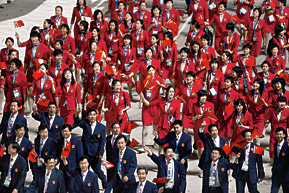 |
| TOP LEFT: CSPA / NEWSPORT / CORBIS; TOP RIGHT: KARIM JAFFAR / AFP / GETTY IMAGES; MIDDLE: MANAN VATSYAYANA / AFP / GETTY IMAGES; BOTTOM: ROSLAN RAHMAN / AFP / GETTY IMAGES; |
For the grand finale, Muhammad bin Hamad Al-Thani of Qatar, on horseback, carries the torch in and up a long, steep flight of stairs to the top of the stadium. The horse, Malibu, struggles to mount the last few rain-slicked steps as a breathless crowd watches. At the top, al Thani touches the torch to the 60-meter (195') cauldron, the tallest ever seen at a major multi-sport event. It rotates dramatically and becomes a giant armillary sphere as an explosion of fireworks fills the night sky.
It’s a flame that was carried to Doha by 3000 torchbearers through 15 countries over 55 days. Starting in India, the torch wove through Thailand, Indonesia, the Philippines, Japan, Korea, China, Iran, Kuwait, Bahrain, Oman and the United Arab Emirates.
Two weeks of athletic competition are to come, but this night, Qatar clears the first hurdle, staging a breathtaking opening ceremony.
“I think we managed to pull off nothing short of a miracle, given the weather conditions that prevailed,” artistic director David Atkins says of the record downpour and the 15- to 20-knot winds that buffeted performers.
 |
| In their turn, the 360 athletes representing Qatar walked into the stadium. |
| RYAN PIERSE / GETTY IMAGES FOR DAGOC |
“We’ve been here planning this for two years, and in that time it’s rained twice. During the opening ceremony, it rained four times.”
Nonetheless, the dazzling opening of the Games caught the eye of the Beijing 2008 Olympic Committee, which came to Doha for guidance. Members of the International Olympic Committee, which Qatar is wooing in its bid to host the 2016 Summer Olympics, also praised the ceremony, faulting only the weather. Most of all, the opening captured the hearts of viewers and spectators.
Ahmed Saleh, flanked by his twins, beams. “We are very proud of the Games to be here,” he says.

 |
| Pakistan’s Muhammad Akram tries to tag one of his Indian opponents during the kabaddi group match, but India won 31–20 to take the gold. Bottom: Pakistani supporters cheer their team. |
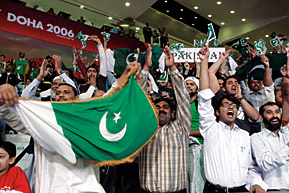 |
| TOP: PETER AUF DER HEYDE / EPA / CORBIS; BOTTOM: KHALED EL-FIQI / EPA / CORBIS |
 he sweat-tinged air is electrifying. Fans in face paint, waving a sea of flags, create a non-stop din in the 1000-seat stadium filled to capacity. Several hundred more who couldn’t get seats spill over into the hallways, watching the match on big-screen tvs.
he sweat-tinged air is electrifying. Fans in face paint, waving a sea of flags, create a non-stop din in the 1000-seat stadium filled to capacity. Several hundred more who couldn’t get seats spill over into the hallways, watching the match on big-screen tvs.
No, this is not the World Cup final. Not even the Superbowl. It is the gold medal kabaddi match between India and Pakistan, one of the biggest fan favorites at the Asian Games.
“I was here three hours before the match to get a seat,” says Salahuddin, deputy chief of mission of the Pakistani National Olympic Committee.
So unknown is the game of kabaddi outside South Asia that when I asked a photo-agency editor about assigning a photographer to cover the sport, he replied, “I don’t know who Kabaddi is, but we’ll do our best to get a picture of him.”
Originating in South Asia some 4000 years ago, kabaddi is known as “the game of the masses” due to its simple format and need for virtually no equipment. It is played between two teams of seven; one player repeatedly chants “kabaddi,” meaning “holding of the breath” in Hindi, and charges the
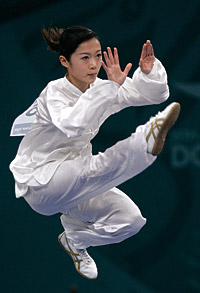 |
| Taiwan’s Fan Man Yun competes in wushu. Bottom: Facing opponents from Vietnam, Nitinadda Kaewkamsai of Thailand serves during the women’s final sepaktakraw match. |
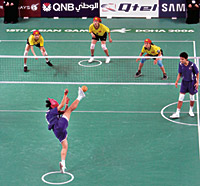 |
| WUSHU: ZAINAL ABD HALIM / REUTERS / CORBIS; SEPAKTAKDRAW: EPA / CORBIS. |
opponent’s court, trying to touch as many as possible. The opposing team tries to catch him, halting the “kabaddi” chant.
Word of the backlot sport is starting to spread. A contingent of us Marines, training with local troops in the Indian state of Karnataka, plays kabaddi in the barracks. Police officers in Toronto are playing it with the city’s large Asian community in an effort to improve race relations. In northern England, the sport has been introduced at a correctional facility at the request of Asian inmates. At this edition of the Asian Games, the traditional kabaddi-playing nations—India, Pakistan and Bangladesh—were joined by newcomers Iran and Japan.
Although familiar sports ranging from archery to swimming dominate the Asian Games, more local sports, such as kabaddi, sepaktakraw and wushu, attract a solid fan base of both the faithful and the curious. “In Pakistan and India, kabaddi games form spontaneously, with everyone in the neighborhood turning out,” Salahuddin says, watching his team fall to India, which takes the gold medal.
Another little-known game, sepaktakraw, originated in Central Asia in the 15th century and resembles volleyball played with the feet instead of hands. Thailand, Indonesia and Malaysia are the traditional Asian Games powerhouses of both the men’s and women’s teams. The tongue-twisting name comes from the Malay sepak meaning “kick,” and takraw meaning “woven ball.” Using only their feet, three-person teams smash a rattan ball over the net, earning a point if their opponents cannot return the ball without letting it touch the ground.
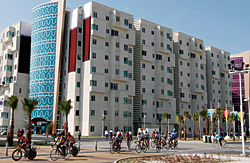 |
| The Athlete’s Village housed most of the 12,500 athletes who participated in the Games. |
| STREETER LECKA / GETTY IMAGES FOR DAGOC |
Wushu, whose name literally means “military art,” originated in China during the Zhou dynasty (1122–255 BC) and, over centuries, developed into routines using hands, swords, spears and cudgels involving stances, kicks, punches, balances, jumps and sweeps.
With 11 more sports than the Olympics, some critics claim the Asian Games are getting unwieldy and should drop the lesser-known sports. But tell that to the packed stadium of fans at the India–Pakistan kabaddi final.

“I’ll definitely have a glass of hot milk to make sure I get a good night’s sleep.”
—India’s Jameeluddin Mohammed on how he will celebrate after beating Oman in beach volleyball.
“We prepared a freestyle with fairly classical music. Unfortunately, Arab music doesn’t fit with the horse’s movements.”
—Omar Khalid al Mannai of Qatar, commenting on his equestrian performance.
“My fitness was really not good enough. Even if I hit the ball hard, it still came back. But I am 35. It’s not bad for an old man, but maybe I should think about playing with the seniors from now on.”
—Abdulrahaman Shebab of Brunei on his tennis loss to Japan’s Toshihide Matsui.
“Once, we beat Bahrain. It was 15 or 20 years ago.”
—Bangladesh soccer captain Arman Aziz, after the team’s 5–1 defeat in a preliminary round.
“We didn’t have a plan. That was a problem, I suppose.”
—Diane Pascua of the Philippines, beach volleyball competitor.
“My opponent was very strong. Because of the height difference, I concentrated more on punching on his stomach.”
—Sri Lankan boxer Chamila Prasad, after beating Saudi Arabia’s Mohammed Malak al Salem. |
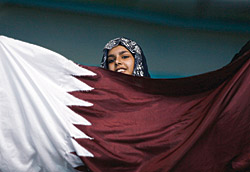 |
| A Qatari fan waves her country’s flag during the swimming heats. |
| JASON REED / REUTERS / CORBIS |

3,000,000,000: Population of countries through which the torch of the 15th Asian Games was carried
1,700,000,000: Estimated television audience for the opening ceremony
800,000: Population of Qatar
160,000: Population in Qatar that is native-born Qatari
50,000: Attendance at the opening ceremony
20,000: Schoolchildren bused to matches at the Games from Qatar schools
19,000: Total volunteers at the Games
15,000: Total number of roses given at Doha airport to each arrival for the Games, from athletes to coaches, trainers, athlete’s family members and media
12,500: Athletes participating in the 15th Asian Games
10,000: Costumes used in the opening ceremony
8,000: Performers from 20 countries and regions participating in the opening ceremony
1,300: Accredited journalists representing 110 nationalities
65: Age of oldest athlete, chess player Emiko Nakagawa of Japan
64: Horses used in the opening ceremony
40: Countries and regions participating in the 2006 Games
39: Sporting events at the Games
38: Countries that won medals
28: Sporting events at the 2004 Athens Olympics
25: Millimeters of rain that fell during the opening ceremony (1")
14: Number of Asian Games records set
13: Days of travel by truck for horses to arrive from Khazakstan
12: Millimeters of rain that fall on average during December in Doha
11: Modes of transport for the torch, including camel, horse, wheelchair, inline skates and mountain bikes
10: Age of the youngest athlete, swimmer Amer Ali of Iraq
8: Number of world records set
8: Number of days per year on average during which it rains in Doha
4: Number of days it rained during the 2006 Games
2: Number of Buddhist monks on the Japanese kabaddi team
1.25: Cost in us dollars of a ticket to the men’s basketball and soccer matches
1: Number of airport terminals built specially for the Gamess
 |
Char Simons (simonsc@evergreen.edu) is a free-lance journalist and former sports reporter, runner and triathlete. She teaches Middle East studies at Evergreen State College in Olympia, Washington. |





